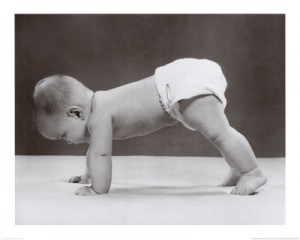This September we happily added Ellynne Skove MA, LCAT, BC-DTR, NCC, RPP to our teaching roster. Ellynne has taken over the Tummy Time program at Prenatal Yoga Center. For those who are not familiar with Tummy Time or the importance of incorporating it into your infant’s daily life, Ellynne has kindly shared an article she wrote about the subject. Hope you enjoy this fascinating piece!
More and more babies are being put to sleep on their backs as a result of pediatricians recommendations to prevent Sudden Infant Death Syndrome. While this practice is suggested for safety and health, many babies are missing out on crucial awake hours of TUMMY TIME due to the habit of placing babies on their backs. Babies are on their backs in strollers, car seats, bouncy seats, & with many play gyms. Tummy Time is becoming lost to our modern inventions.
What is TUMMY TIME?
Simply put, TUMMY TIME is any opportunity a baby has to spend using her stomach. This could be directly on the tummy on a flat surface, or it could be while being carried by a loved one in their arms, or in a good baby carrier facing inwards.
Why is TUMMY TIME important?
TUMMY TIME prevents the flattening of the head that can occur when a baby spends too much time lying on her back. TUMMY TIME gives the baby opportunities to progress in the natural blueprint of movement sequences that enable her to sit up and later stand in the vertical position. In particular, TUMMY TIME, and the Developmental Movement patterns, help develop the spinal curves and muscle strength needed to move onto all fours and begin balancing. This leads to creeping, crawling, sitting, scooting, standing, and walking upright. This sequence is called Developmental Movement. Without going through these movements the brain does not achieve its full opportunity to develop the corpus colosum, which enables the right and left hemispheres to transmit information between one another. Many learning challenges can be traced to missed developmental movement patterns in the first year of lifeÂ
. particularly crawling. The Developmental Movement patterns are like a big puzzle. There are many pieces and babies find varying ways of puttiing them all together to find their way to standing vertically. Genetics, environment, and opportunities for activity also play a role in how quickly a baby will move through these patterns.
What are the Developmental Movement Patterns?
Developmental Movement Patterns are based on three forces: PUSH, PULL, and REACH. There are four basic components: NAVAL RADIATION, HOMOLOGOUS MOVEMENTS, HOMOLATERAL MOVEMENTS, AND CONTRALATERAL MOVEMENTS. Naval Radiation occurs when a baby is first born. If you watch your baby closely you will see that her breath and movements initiate from the radius of her body, which is at her navel. This has been the center for her nourishment and connection to mother for the first nine months so it is no wonder that this is where the movement begins.
Homologous movement is from head to tail. This is seen with the lifting of the head and chest, the pushing of the tummy, arms, and later hands, into the floor to lift and reach the chest, head, and eyes. From the tail we see the lifting of the tailbone upward into what looks a lot like the yoga pose called Âawkward pose or Âknees, chest, and chin. The feet may try to push into the floor. Sometimes there is a push pull kind of rocking from head to toes that occurs. As homologous movements develop, naval radiation movements lessen. At the earliest stages the babyÂs feet do not touch the ground. Once they do a lot more movement begins.
The baby becomes even more alert and curious as the senses engage more fully and the body develops muscle and bone strength. Homolateral movements are same sided. Often we see the baby put her foot into her mouth and hold it there with the same hand. This is both homologous and homolateral. This is often the precursor Âpuzzle piece to side lying and later rolling. Once these are mastered Tummy Time is often much more comfortable. The baby begins to use her hands to when on her belly, and we see the ability to move in circles and then movement backwards. This takes immense strength and sets the tone for Creeping or, Âcommando crawling, on the belly like a salamander, which is a homolateral movement. ÂJumping Jacks are an upright homolateral movement. If we try to walk homolaterally we end up walking like Frankenstein, or a penguin. It is awkward and the flow of breath and movement through the center of the body is constricted.

Contralateral movements cross the midline of the body and consequently trigger the corpus colosum of the brain to transmit from left brain to right brain and vice versa. This is where singing or babbling becomes speech. There are many ways for babies to go through these patterns. It is important for all babies to crawl. Even if a baby walks first it is important to try to get the baby to crawl too. One can go back through the Developmental Movement Patterns again and again in life to relearn them and retrain the brain. It is even possible to do this with people who have experienced strokes.
Try not to place your baby in a free sitting position before crawling. Allowing your baby to put her Developmental Movement Âpuzzle pieces together herself to find her way to sitting independently is not only better for her spine, but also for her sense of self accomplishment! Until your baby can sit independently have her sit in a semi reclined position. This could include your lap, a bouncy seat, a reclining high chair, or a car seat. There are some products on the market that claim to help your baby learn to sit. Molded plastic seats that force your baby into a position before your baby can sit independently can actually cause damage to the spine and neck. When the baby is ready to sit, she will do so on her own. This is when her body is now truly developed in spinal strength to hold up that big baby head!
How to do TUMMY TIME
During prone TUMMY TIME talk, sing, and play with your baby. Keep her interested and engaged! Use toys, scarves, and instruments to help. This is a great bonding time for baby and caregivers! Do it a little at a time and keep building it up over time. Diaper changing time is a great opportunity to add in some TUMMY TIME and play. This happens multiple times in a day so it could become a routine part of diapering. Massaging your baby on her tummy amidst diaper changing is a wonderful way to create a relaxing and soothing Tummy Time experience. Singing favorite lullabies or other gentle songs while doing this is beneficial for everyone. Try different surfaces to see which one your baby is most comfortable on. The bed, floor, a soft sheepskin mat, lying on your chest and belly while you lie down too, the changing table are all different kinds of surfaces to explore. Expect it to be a struggle at first. In fact, the best way to help your newborn  4 month old with Tummy Time is to wear her in a good front carrier or baby wrap! And of course, carrying your baby in your arms is a wonderful way for her to feel your heart next to hers while she tries to push her belly into you to lift her head.
Frequency and duration of TUMMY TIME
Try to work up to about 30 -40 minutes a day spread out through different segments of the day. Do not expect a newborn to do this much. IT is a process of building!
When to Begin TUMMY TIME
You can begin placing your baby on her belly on a flat surface as soon as the umbilical cord has fallen off. Newborns will begin by rooting around with their heads and work to begin lifting their heads. Babies of four months and up who have learned to lift their heads and hold them up will be pushing on the floor with their hands and arms to look around more and track sounds or objects. They will look more like they are in baby cobra or sphinx yoga poses. Certainly Tummy Time has begun the moment you hold your baby in your arms, as discussed before, by using a good baby carrier to wear your baby.
What if my baby fusses during TUMMY TIME?
Many parents tell me their baby does not like TUMMY TIME. While it is true that many babies will struggle and fuss during TUMMY TIME early on, this is not a reason to stop doing it! The real issue to look at is WHY it might be a struggle for a baby. First, consider that the baby spent its first nine months of life in the liquid floating space of the womb. The world of gravity is a real surprise after a life of floating! Secondly, during infancy the head is the biggest and heaviest part of the body. It is bigger than the babyÂs bottom! Imagine if your head was bigger than your bottom! It would be a struggle to lift your head up too wouldnÂt it? Thirdly, the babyÂs spine has minimal curves when born. The Developmental Movement patterns help to develop those curves, which create the foundation and architecture for the body to stand up. All of this requires a lot of effort and work for the baby. It is a bit like adults hitting the gym after a long period of not working out. Afterwards our bodies ache, and during, it is often a push to stick with it. It is the same for babies. Whatever you do, donÂt make up your babyÂs mind about whether she likes it or not. Babies are intelligent and pick up everything you do and say. You donÂt want to inadvertently set a negative precedent. Babies change and grow constantly. IF your baby is struggling, you can ease this somewhat by using a nursing pillow or small blanket roll under the babyÂs chest. Give your baby a chance to keep trying. DonÂt push it to frenzy. See what your babyÂs edge is and then stop. If your baby cries at a level of true discomfort then stop and soothe her. Resume carrying your baby or wearing your baby. It is important to carry your baby facing inwards in a carrier until you are sure your baby can really hold her head up well. They need the support of their belly pushing against you while wearing a carrier to work on holding up their heads! Facing a baby out too soon can cause distress to the spine. There is plenty of time. You donÂt need to hurry things. Let your babyÂs innate intelligence guide you. Become a good observer! Praise your baby for all of her hard earned accomplishments!
What if my baby scoots on her bottom or does not crawl before standing?
If your baby scoots on her bottom instead of crawling offer the chance to crawl through a play tunnel or under some kitchen chairs. Crawl around with your baby and model it for her. Babies love to imitate! If your baby stands and walks before crawling try to continue offering opportunities to crawl.
Bonding with your baby through Tummy Time and Renewing Yourself
Resting on your own tummy next to or opposite your baby is a wonderful way to model relaxation, full breathing, and playfulness. It gives you the chance to view the world from your babyÂs perspective. Let your mind calm and tune into the wonders of the senses that motivate your babyÂs curiosity: sight, smell, touch, sound, and movement. Connect in to how your baby experiences life and enjoy the break from your hardworking Âthinking” mind! This offers you a chance for renewal and restoration while bonding with your baby. When your baby is very young, lie on the floor with your baby on your own belly so baby is having heart to heart Tummy Time. This feels good for both of you!
More about Ellynne!
Ellynne Skove, MA, LCAT,BC- DTR, NCC, RPP, is a New York state licensed Movement therapist, yoga teacher, Orff music educator, nationally certified counselor, and Polarity therapist. In 2010 Ellynne completed additional graduate studies in Pre and Peri Natal Psychology at The Santa Barbara Graduate Institute. She has worked for over 25 years with pregnant women, babies, chidren, and adults. Ellynne studied developmental movement/Dynamic Anatomy with the late Nancy Topf for 15 years, Body/Mind Centering, Brain Gym and Yoga for the Special Child.



